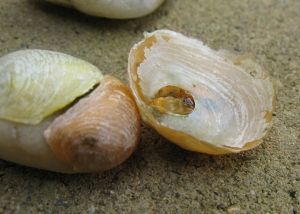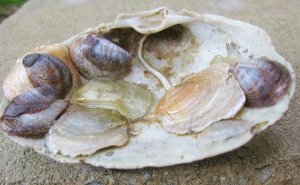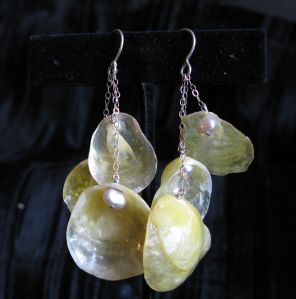I am fortunate. I get to walk on the beach every morning! Among the treasures we find, none are as cheery and colorful as jingle shells. They are so named because artisans have long been assembling them in to lamp shades and wind chime curtains. When you shake them they truly do jingle. Their scientific name is Anomia simplex. They also go by “Neptune’s toe nails” or the amusing misnomer “Mermaid’s toe nails”. Another name is “Saddle Oyster”, which indicates that Anomia are related to oysters. However, Anomia taste bitter and are of no commercial value.
They are found along the entire Atlantic sea coast from Nova Scotia to Brazil. A hardy species it seems. Anomia are mollusks (within the group of bivalves) that attach themselves to a surface by means of the ‘bysuss’, a tuft of calcified fibrils that penetrates through a hole in the lower valve to adhere to the underlying surface (see Figures1,2).

Figure 1: Yellow and orange Anomia adherent on a beach stone and Anomia with inner valve attached depicting the hole for the bysuss.
This may be a large clam shell, a rock, or another hard surface such as logs, wharfs or boats. They live in shallow waters often close to the beach, in a bay or estuary. The upper valve is brightly colored, either a shiny yellow or orange. Shades of silvery grey and black are present when Anomia are submerged in the mud and silt at the sea bottom. Interestingly, the lower valve is white, light grey or colorless. Is the bright yellow or orange color perhaps dependent on light filtering through the shallow waters? Is the purpose of the color to protect against a predator such as oyster drills, starfish and crabs (which are collectively referred to as boring gastropods). This seems unlikely as predators are supposed to find their food by scent not sight, as pointed out to me by Paul Monfils.

Figure 2: Two Anomia adherent on a beachstone. The orange upper valve has detached revealing the lower valve and the adherent mollusk.
Anomia shells are extremely thin and paper-like such that they are often translucent, thus easy prey, one would think. Small holes are frequently found on the upper valve usually placed just where the animal is situated at the top of the shell. These small holes look like the mark of a predator, but they are by no means present on all shells that wash up on the beach. These animals must die of other causes too.
Personally I am most interested in their color. Why either yellow or orange? And how do these bright colors serve to enhance survival of this species.

Figure 3: Bright yellow and orange Anomia simplex adhering on a beach stone.
My own observations from our beach, situated on a natural bay of Long Island (New York State) are that greater than 99% of Anomia are either yellow or orange, the rest being either silvery, or blackened. Neither yellow or orange predominate. These numbers do not vary dramatically with the tides or with the seasons (e.g. temperature). Both yellow and orange come in all sizes varying between approx 1-4 cm in diameter. Both yellow and orange are susceptible to drill holes (see above). Yellow and orange animals cohabitate in close proximity on rocks or large clam shells. They may even adhere partially on top of each other and they share their solid surface habitat with others shells, mostly Crepidula fornicata (slipper shell), as shown in Figure 3,4. The latter are considered an invasive species and are known to damage commercial oysteries: http://www.jncc.gov.uk/page-1711

Figure 4: Several Anomia simplex (5) of different colors and slipper shells (6) all adhering to a single large clam shell.
Anomia collected from different locations may have different colorings. Anecdotal evidence (courtesy of Steve Rosenthal) has it that Anomia collected from western beaches of Long Island are less brightly colored than those from the eastern beaches. And pictures of Anomia from Florida beaches (http://www.squidoo.com/seashell-identification) reveal many shades of silvery white and grey and black, that seem much less prevalent on our beaches. Thus location and habitat my affect coloring.
Different colors and patterns on scallops and mussel shells are genetically determined. Therefore it is likely that the yellow and orange colors of Anomia could also be genetically encoded. Since Anomia can be bred in the laboratory I would like to know whether all offspring of yellow Anomia are yellow and those of parental orange color remain orange. The enigmatic question of how the color helps this organism survive could be experimentally addressed with laboratory experiments in which selected predators are added in a controlled way.
In the meantime I will continue to walk the beaches and collect Anomia to make ear rings and other colorful jewelry (Figure 5). Out here these shells are quite familiar and are collected by many beach goers. They remind us all of hot summer days on the beaches of Long Island.

Figure 5: Jingle ear rings with yellow pearls, with hematite, with green onyx and with turquoise beads (from left to right).
See:
http://www.etsy.com/shop/maidstonejewelry?ref=si_shop&view_type=list
http://www.maidstonejewelry.com
For more on Jingle Shells click here.
Further reading:
1) Partial Metamorphosis in Anomia simplexAuthor(s): V. L. Loosanoff. Science, New Series, Vol. 133, No. 3470 (Jun. 30, 1961), pp. 2070-2071.
2) Genetics of shell color in mytilus edulis l. and the association of growth rate with shell color. Gary F. Newkirk J. Exp. Mar. Biol. Ecol., 1980, Vol. 47. pp. 89-94.
3) Comparison of the composition of fossil and recent mollusk shells. Pilkey OH, Goodell, HG. Geological Soc of Amer Bulletin, 75:217-228, 1964.
4) A Jingle (Shell) in Your Pocket, By Patricia B. Mitchell.
http://www.mitchellspublications.com/guides/shells/articles/0001/
5) http://www.marinespecies.org/aphia.php?p=taxdetails&id=156737
6) Wikipedia http://en.wikipedia.org/wiki/Anomiidae


Here are averages from a few months of counts from our beach regarding Anomia simplex relative frequency (percentages all based on counting several hundred shells from photographs taken at 2 different locations on 10 different occasions):
Anomia simplex 6.9
Crepidula fornicata 91.3
scallops 1.6
periwinkle 0.0
whelk 0.0
Anomia simplex colors:
yellow 51.6
orange 46.2
blackened 0.4
silver 0.0
cream 1.8
David,
Thanks for providing such a detailed piece on this shell!
As a fellow Long Island beachcomber, many of my beach days
have been spent nearby these shells and it amazed me to
find out how little I’ve known of the species. It was especially
fascinating to discover that certain color variants predominate
on either end of Long Island.
Your earrings fashioned from “Neptune’s Toe Nails” (and the rest of your work as well)–all this reflects your keen powers of observation, your sensitive use of color and your love of natural forms.
John Todaro
Hey, thanks John. You can be my blog critic any time!
Fascinating background on these ephemeral shells. I love the beautiful, thoughtful way that you use them in jewelry! I pick jingles up from the shallow mudflats of Jamaica Bay, where they wash up in the high tide line. Each one is such a thrilling treasure. I read an article about your work that described an epoxy that you use to strengthen these delicates. Could you please tell me which one it is and how you get your best results? Gratefully, Jem
Thanks for your comment. Which article are you referring to? There are various epoxies that you can use. Just beware, they are quite toxic! I work under a ventilation hood and use plastic gloves. Would love to know what color jingle shells you find on Jamaica Bay and whether they differ from those we find out here on the East End (see my table in the first comment above). David
We have these in Oregon, too! I just found the name of them (and your article!), although I’ve been collecting them for years and years. Last year for a local craft fair I made necklaces out of them, with a little pearl or a three-pearl drop at the top, similar with what you’ve done with the earrings. I had never seen these made into jewelry before, but your earrings are beautiful! In Oregon, most shells are silver-white with green in the middle (which makes sense, because I believe our variety is called the Green False-Jingle – not sure why it’s false…), although they are also orange to pinkish-orange. Sometimes they will have a purple or blue iridescent sheen if they are mostly white. Unfortunately, I rarely find them unbroken, and nowhere near as regularly-shaped as the ones you’ve pictured.
Thanks for your input. I will try to find out why your shells are called “false” jingle shells. Can you send pictures of your green jingles?
I think “false” jingle shells are a different species called Monia Umbonata:
http://en.wikipedia.org/wiki/Anomiidae
I use lamp shades with CFL bulbs instead of incandescent lamps, they are much cooler and uses less electricity
Arnulfo, thanks for the tip. Yes, it is a good point, heat can damage the shells!
,;- I am really thankful to this topic because it really gives great information `-`
;’; that seems to be a great topic, i really love it ‘:;
Excellent post!! I really like your site!!
Thanks for your comment.
Hello. I didn’t realize that there were so many lovers of jingle shells. I have been collecring these shells for years and decided to make a windchime, which I’m currently working on now and would also like to include these shells in my jewelry making. I read that you use an epoxy glue to strenghten them.
Could you please tell me the name of the epoxies you have used. Just to mention that I am very well versed in the use of materials which require
adequate ventilation. Of note I have found that the North Shore of L.I. generally
has an adundance of pale yellow, dark yellow and orange jingle shells with a
few white shells thrown in. On Rockaway Beach in Queens the colors range from silver, beige, light and dark brown and black but these are not found in abundance ason the north shore. If you could email the information to me it would be greatly appreciated. Thank you.
Lisa:
I agree with your observations. The colors are clearly different on the Atlantic beaches versus the bay beaches of Long Island – I have the same data. I have sent you info on the epoxy.
David
hey great blog!!! i was just at the beach today and we have jingle shells here in CT. they are one of my favoret shells im planing on doing some crafts withe the bunch that i got . do u have any sugestions ????
The key is to treat the shells with something like 2-ton epoxy so that they are hard and do not crumble.
I love your post, it’s nice when you can tell somebody actuallly puts effort into a site, and gives the sites. If you set up updates value.
Wow that was unusual. I just wrote an really long comment but after I clicked submit my comment didn’t appear. Grrrr… well I’m not writing all that over again. Anyways, just wanted to say great blog!
What a fabulous condensed editorial I sincerely loved it
As a final note , let me thank you for your understanding with my English as (I am sure you have figured this at this moment ,), English is not my principal language hence I am utilizing Google Translate to figure out how to record what I actually want to articulate.
I love when I find jingle shells in different colors at the same beach since most of the time one or two colors may dominate. I recently went to a small town beach on Long Island and found a good amount of jingle shells ranging from pearl white, peach, dark orange, yellow, silver, grey, brown & black. Some I find are also flat. I made wind chimes using yellow & peach/orange and used driftwood to hang the strands of shells, it is really beautiful and the sound is so pleasant.
Interesting Lisa! Where is that small town beach you speak of Lisa?
If you check our recent posts on “40 Beaches of East Hampton” I have included a description of what types of shells you can find on each beach! Surprisingly, at least to me, every beach is quite different.
Thanks so much for your article. I was collecting shells yesterday (I’m from Sydney Australia) and was only thinking of these shells I used to collect as a kid on holidays with my parents. Low and behold, my heart skipped a beat when I found one solitary jingle shell amongst a plethora of mixed shells.
Wasn’t aware of their name, until I googled shiny orange shell and found your article.
thanks Lyn. I am glad you found this helpful.
Are they worth anything? I have ones in all colors, big and small. I want to sell them but what are they worth?
I don’t know, Hailey. I have never heard of anyone selling jingle shells… they are so copious on our beaches. But, I can imagine that if you live somewhere where there are no beaches and if you are in to making things with shells, you might have a need… People have made lamp shades or wind chime shell curtains using jingle shells. You would need quite a large quantity for such a project.
http://www.rugsandblinds.com/weird-curtain-beyond-just-fun.aspx
I guess you could try and sell your shells on etsy.com?
I got envious of you just by reading the first two lines. These shells are amazing. So are you selling the products made from shells? Are you processing the shells before making a product out of it?
go to our etsy store for the latest jingle shell products (ear rings and more). Yes, the jingle shells need to be treated with 2-Ton Epoxy or else they are too fragile and will shatter.
Greetings from California! I’m bored at work so I decided
to check out your website on my iphone during lunch break.
I really like the information you provide here and
can’t wait to take a look when I get home. I’m surprised at how fast your blog loaded on my mobile ..
I’m not even using WIFI, just 3G .. Anyhow,
wonderful blog!
I almost cried while reading your blog. The reason? I live in California, in the San Francisco Bay Area, and have since 1970. But by heritage I am a Long Island girl, who spent every summer of my childhood, at least up to college, at my grandmother’s bungalow in Noyac. We would frequently go shelling on Long Beach, and adjacent Short Beach, as well as myriad other beaches. My heart has never left the East End. Even your use of the names makes me sigh like an exile.
My grandmother was born in Bridgehampton, but grew up at the Old House in Noyac. Her husband was born in Sag Harbor. Our ancestry goes back to 1640 and the settling of Southampton. A dyed-in-the-wool East Ender, even if I was born on Manhattan and grew up in Rockville Centre.
My sister just sent me a LARGE box – flat rate priority mail box – filled, FILLED to the top with jingle shells that she and I collected in the 1950s, mostly at Towd Point. And then I found your blog. It made me so very homesick for Noyac and the East End. I have been washing the shells and I plan to put them in a large clear glass vase, just to be able to look at them.
In addition to the jingles, there were a few boat shells, and one slipper shell. Do you know the scientific names for these shells?
Thanks, again, for the quick trip to Long Beach, the one in Noyac, although the one just west of Jones is a favorite beach for ocean swimming.
Thanks for sharing, Dee. Hope to see you on East End beaches very soon. 🙂 David
How do you take off the hard, white spots on the insides of jingle shells?
The white spots are calcium carbonate precipitates which can be dissolved with acetic acid (vinegar) but this may also affect the shell itself! I sometimes scratch them off. Often I just leave them. Let us know what works best for you!